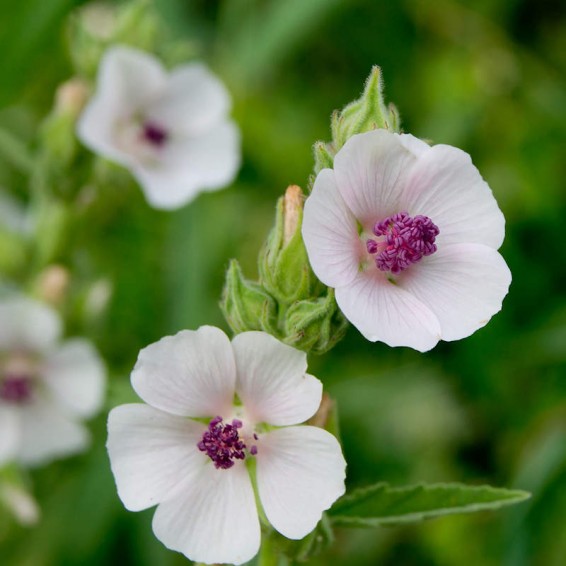Marsh Mallow Seeds
Althaea officinalis
- HOW TO GROW
- FAST FACTS
HOW TO GROW
Sowing: Direct sow the Althaea Officinalis seed in late summer or early fall; the seed will remain dormant until spring. If not planted in the fall, these Marsh Mallow seeds will need to be stratified to break their dormancy. Mix the seed with an equal amount of sand and store it in the refrigerator for 4-6 weeks. Start the Althaea Officinalis seeds indoors in a flat, just below the surface. Keep the soil evenly moist and at a temperature of 70 degrees F until sprouting. The germination rate may be naturally low. As soon as the seedlings can be safely handled and there is no chance of frost, transplant them.
Growing: Since this plant naturally grows in marshy ground, the plants will need to be watered well to keep the soil moist. It prefers moist to wet soil and full sun, though it also adapts to well-drained soil. Plants can also be propagated by division. A layer of mulch will help conserve moisture and control weeds. Established plants will self seed, but volunteer plants can easily be transplanted or removed. This plant attracts hummingbirds, bees, and butterflies.
Harvesting: The sweet, thick taproot of Marsh Mallow can be harvested in the autumn from plants of at least two years growth. If a few small roots are left on the plant, it will continue to grow. Eaten fresh as a vegetable, the roots have a taste similar to a parsnip. They can also be dried for later use. The leaves can be harvested individually and used fresh or dried for tea, poultices, or tinctures.
Seed Saving: After the flowers fade, a seed pod will develop. When the pods begin to dry and the seeds inside ripen to a brown, remove the pods individually and spread them out to dry. Separate the seed from the pods and store the cleaned Althaea Officinalis seed in a cool, dry place.
FAST FACTS
Common Names: Common Marshamllow, White Mallow
Latin Name: Althaea officinalis
Species Origin: Europe
Type: Garden Flowers
Life Cycle: Perennial
USDA Zones: 3, 4, 5, 6, 7
US Regions: Midwest, Northern, Northeast
Seeds per Ounce: 12,000
Stratification: No Stratification
Germination Ease: No Stratification
Sunlight: Full Sun
Height: 36 Inches
Color: Pink
Bloom Season: Blooms Late Summer
DESCRIPTION

HOW TO GROW
Sowing: Direct sow the Althaea Officinalis seed in late summer or early fall; the seed will remain dormant until spring. If not planted in the fall, these Marsh Mallow seeds will need to be stratified to break their dormancy. Mix the seed with an equal amount of sand and store it in the refrigerator for 4-6 weeks. Start the Althaea Officinalis seeds indoors in a flat, just below the surface. Keep the soil evenly moist and at a temperature of 70 degrees F until sprouting. The germination rate may be naturally low. As soon as the seedlings can be safely handled and there is no chance of frost, transplant them.
Growing: Since this plant naturally grows in marshy ground, the plants will need to be watered well to keep the soil moist. It prefers moist to wet soil and full sun, though it also adapts to well-drained soil. Plants can also be propagated by division. A layer of mulch will help conserve moisture and control weeds. Established plants will self seed, but volunteer plants can easily be transplanted or removed. This plant attracts hummingbirds, bees, and butterflies.
Harvesting: The sweet, thick taproot of Marsh Mallow can be harvested in the autumn from plants of at least two years growth. If a few small roots are left on the plant, it will continue to grow. Eaten fresh as a vegetable, the roots have a taste similar to a parsnip. They can also be dried for later use. The leaves can be harvested individually and used fresh or dried for tea, poultices, or tinctures.
Seed Saving: After the flowers fade, a seed pod will develop. When the pods begin to dry and the seeds inside ripen to a brown, remove the pods individually and spread them out to dry. Separate the seed from the pods and store the cleaned Althaea Officinalis seed in a cool, dry place.
FAST FACTS
Common Names: Common Marshamllow, White Mallow
Latin Name: Althaea officinalis
Species Origin: Europe
Type: Garden Flowers
Life Cycle: Perennial
USDA Zones: 3, 4, 5, 6, 7
US Regions: Midwest, Northern, Northeast
Seeds per Ounce: 12,000
Stratification: No Stratification
Germination Ease: No Stratification
Sunlight: Full Sun
Height: 36 Inches
Color: Pink
Bloom Season: Blooms Late Summer





